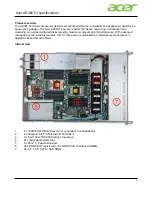
1/20/97
N
N
T
T
S
S
-
-
2
2
0
0
1
1
.
.
M
M
A
A
N
N
3
3
-
-
1
1
8
8
R
R
e
e
v
v
.
.
A
A
output string format may be changed with Serial I/O Function F11. The default output
string format is:
<SOH>DDD:HH:MM:SSQ<CR><LF>
where
<SOH>
= ASCII Start-of-Header character (HEX 01).
<CR>
= ASCII Carriage Return character (HEX 0D).
<LF>
= ASCII Line Feed character (HEX 0A).
DDD
= day-of-year.
HH
= hours.
MM
= minutes.
SS
= seconds.
:
= colon separator.
Q
= time quality character.
The time quality character may be a:
SPACE
which indicates a worst-case error less than
threshold 1.
.
which indicates a worst-case error greater than or
equal to threshold 1
*
which indicates a worst-case error greater than or
equal to threshold 2.
#
which indicates a worst-case error greater than or
equal to threshold 3.
?
which indicates a worst-case error greater than or
equal to threshold 4.
3.33.2
Refer to serial I/O function 13 - WORST-CASE-TIME ERROR REQUEST. The carriage
return character <CR> start bit begins on the second, +0 to +1 bit time or ±1 ms, which
ever is larger. Time will continue to output once per second until the port receives a
CONTROL-C character (HEX 03). Until it receives a CONTROL-C the port will ignore all
other input.
3.34
FUNCTION 09 - TIME ON REQUEST ENABLE
3.34.1
When the Serial I/O port receives the command string F09<CR> it waits for a request in
the form of an upper-case ASCII character T to output the time-of-day string. After a T is
received, the current time is saved (with a resolution of 1ms) in a buffer and is then
transmitted to the port. The port will continue to respond with time-of-day each time it
receives a T until this function is canceled by sending a CONTROL-C character (HEX
03) to the port (all other input will be ignored until then). The default output string is as
follows:
<SOH>DDD:HH:MM:SS.mmmQ<CR><LF>
















































